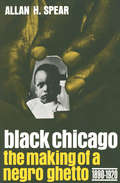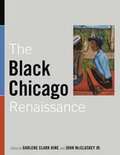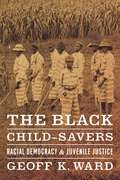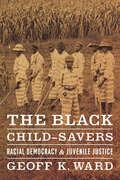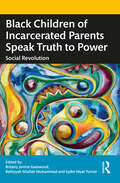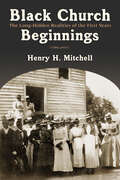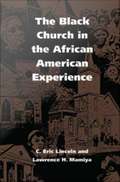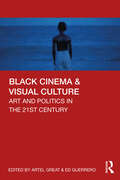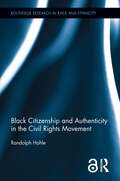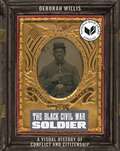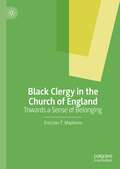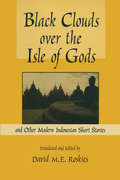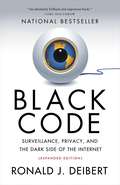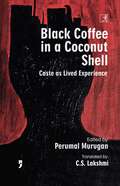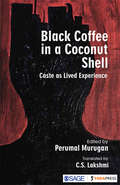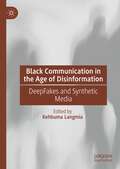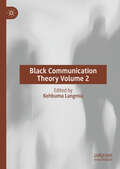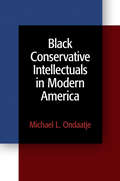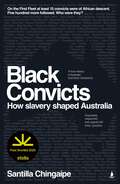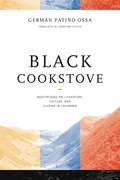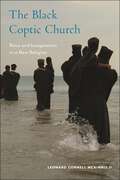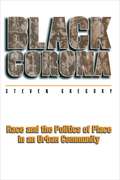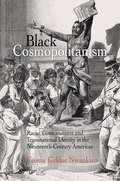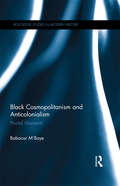- Table View
- List View
Black Chicago: The Making of a Negro Ghetto, 1890–1920
by Allan H. SpearAllan Spear explores here the history of a major Negro community during a crucial thirty-year period when a relatively fluid patter of race relations gave way to a rigid system of segregation and discrimination. This is the first historical study of the ghetto made famous by the sociological classics of St. Clair Drake, E. Franklin Frazier, and others—by the novels of Richard Wright, and by countless blues songs. It was this ghetto that Martin Luther King, Jr., chose to focus on when he turned attention to the racial injustices of the North. Spear, by his objective treatment of the results of white racism, gives an effective, timely reminder of the serious urban problems that are the legacy of prejudice.
The Black Chicago Renaissance
by Darlene Clark Hine John MccluskeyBeginning in the 1930s, Black Chicago experienced a cultural renaissance that lasted into the 1950s and rivaled the cultural outpouring in the Harlem Renaissance of the 1920s. The contributors to this volume analyze this prolific period of African American creativity in music, performance art, social science scholarship, and visual and literary artistic expression. Unlike Harlem, Chicago was an urban industrial center that gave a unique working class and internationalist perspective to the cultural work being done in Chicago. This collection's various essays discuss the forces that distinguished the Black Chicago Renaissance from the Harlem Renaissance and placed the development of black culture in a national and international context. Among the topics discussed in this volume are Chicago writers Gwendolyn Brooks and Richard Wright, The Chicago Defender and Tivoli Theater, African American music and visual arts, and the American Negro Exposition of 1940. Contributors are Hilary Mac Austin, David T. Bailey, Murry N. DePillars, Samuel A. Floyd Jr., Erik S. Gellman, Jeffrey Helgeson, Darlene Clark Hine, John McCluskey Jr., Christopher Robert Reed, Elizabeth Schlabach, and Clovis E. Semmes.
The Black Child-Savers: Racial Democracy and Juvenile Justice
by Geoff K. WardDuring the Progressive Era, a rehabilitative agenda took hold of American juvenile justice, materializing as a citizen-and-state-building project and mirroring the unequal racial politics of American democracy itself. Alongside this liberal "manufactory of citizens," a parallel structure was enacted: a Jim Crow juvenile justice system that endured across the nation for most of the twentieth century. In The Black Child Savers, the first study of the rise and fall of Jim Crow juvenile justice, Geoff Ward examines the origins and organization of this separate and unequal juvenile justice system. Ward explores how generations of "black child-savers" mobilized to challenge the threat to black youth and community interests and how this struggle grew aligned with a wider civil rights movement, eventually forcing the formal integration of American juvenile justice. Ward's book reveals nearly a century of struggle to build a more democratic model of juvenile justice--an effort that succeeded in part, but ultimately failed to deliver black youth and community to liberal rehabilitative ideals. At once an inspiring story about the shifting boundaries of race, citizenship, and democracy in America and a crucial look at the nature of racial inequality, The Black Child Savers is a stirring account of the stakes and meaning of social justice.
The Black Child-Savers: Racial Democracy & Juvenile Justice
by Geoff K. WardDuring the Progressive Era, a rehabilitative agenda took hold of American juvenile justice, materializing as a citizen-and-state-building project and mirroring the unequal racial politics of American democracy itself. Alongside this liberal "manufactory of citizens,” a parallel structure was enacted: a Jim Crow juvenile justice system that endured across the nation for most of the twentieth century. In The Black Child Savers, the first study of the rise and fall of Jim Crow juvenile justice, Geoff Ward examines the origins and organization of this separate and unequal juvenile justice system. Ward explores how generations of “black child-savers” mobilized to challenge the threat to black youth and community interests and how this struggle grew aligned with a wider civil rights movement, eventually forcing the formal integration of American juvenile justice. Ward’s book reveals nearly a century of struggle to build a more democratic model of juvenile justice—an effort that succeeded in part, but ultimately failed to deliver black youth and community to liberal rehabilitative ideals. At once an inspiring story about the shifting boundaries of race, citizenship, and democracy in America and a crucial look at the nature of racial inequality, The Black Child Savers is a stirring account of the stakes and meaning of social justice.
Black Children of Incarcerated Parents Speak Truth to Power: Social Revolution
by Britany Jenine Gatewood Bahiyyah Miallah Muhammad Sydni Myat TurnerThis book centers directly impacted Black children who have lived through parental incarceration. Their stories are told from holistic perspectives incorporating the full range of collateral consequences. Shifting from the Eurocentric and capitalistic viewpoint, they move us beyond negative outcomes to a positive prism by providing insider perspective, strategy, advice, and compelling experiences. We center Black children of incarcerated parents’ (BCOIP’s) rich narratives to show how they are conscious thinkers with perspectives that can help reimagine all Black children’s lives and futures. These stories help readers better understand the importance of exploring the revolutionary ways BCOIP continue to survive, thrive, and transform amid the dynamic challenges surrounding mass incarceration. The book shifts the social dialogue from fear of intergenerational crime and incarceration to resilience, success, Black joy, and self-love, and moves from sympathetic into an empathetic agenda. The book brings to the forefront counter-storytelling through oral narratives that fill a gap in literature that leaves out the voices of children of incarcerated parents who are doctors, lawyers, professional athletes, musicians, community leaders, activists, professors, teachers, bestselling authors, and much more. These are vital experiences to share because not all BCOIP will end up in prison, jail, or a detention center. Black Children of Incarcerated Parents Speak Truth to Power will be of great interest to scholars from the humanistic social sciences and humanities. It is also a timely resource for students (high school, undergraduate, and graduate) in sociology, criminology, corrections, humanities, social work, counseling, education, social justice, and related courses, as well as agency administrators, community organizations servicing families of the incarcerated, specifically incarcerated parents and the children of incarcerated parents, themselves.
Black Church Beginnings: The Long-Hidden Realities of the First Years
by Henry H. MitchellBlack Church Beginnings provides an intimate look at the struggles of African Americans to establish spiritual communities in the harsh world of slavery in the American colonies. Written by one of today's foremost experts on African American religion, this book traces the growth of the black church from its start in the mid-1700s to the end of the nineteenth century.As Henry Mitchell shows, the first African American churches didn't just organize; they labored hard, long, and sacrificially to form a meaningful, independent faith. Mitchell insightfully takes readers inside this process of development. He candidly examines the challenge of finding adequately trained pastors for new local congregations, confrontations resulting from internal class structure in big city churches, and obstacles posed by emerging denominationalism.Original in its subject matter and singular in its analysis, Mitchell's Black Church Beginnings makes a major contribution to the study of American church history.
The Black Church in the African American Experience
by C. Eric Lincoln Lawrence H. MamiyaBlack churches in America have long been recognized as the most independent, stable, and dominant institutions in black communities. In The Black Church in the African American Experience, based on a ten-year study, is the largest nongovernmental study of urban and rural churches ever undertaken and the first major field study on the subject since the 1930s. Drawing on interviews with more than 1,800 black clergy in both urban and rural settings, combined with a comprehensive historical overview of seven mainline black denominations, C. Eric Lincoln and Lawrence H. Mamiya present an analysis of the Black Church as it relates to the history of African Americans and to contemporary black culture. In examining both the internal structure of the Church and the reactions of the Church to external, societal changes, the authors provide important insights into the Church's relationship to politics, economics, women, youth, and music. Among other topics, Lincoln and Mamiya discuss the attitude of the clergy toward women pastors, the reaction of the Church to the civil rights movement, the attempts of the Church to involve young people, the impact of the black consciousness movement and Black Liberation Theology and clergy, and trends that will define the Black Church well into the next century. This study is complete with a comprehensive bibliography of literature on the black experience in religion. Funding for the ten-year survey was made possible by the Lilly Endowment and the Ford Foundation.
Black Cinema & Visual Culture: Art and Politics in the 21st Century
by Artel Great Ed GuerreroThis culturally and politically timely collection examines new Black films and moving images that have, once again, excited and possibly shifted the global media landscape. At a moment some scholars have described as post-post-racial, Black Cinema & Visual Culture provides new, urgent definitions and theories for Black cinema and furthers the development of its critical discourses. Gathering some of the leading scholars and critics in the field, this book enriches and advances the study of Black film and media and its social and political implications at a breakthrough period of expansion in the 21st century. This anthology tackles a wide range of topics from social justice, new media, and Afrofuturism, to race, gender, sexuality, mass incarceration, cultural memory, and Afrosurrealism, exploring the current climate of Black cinematic art that has proven wildly popular with domestic and global audiences, including hit films like Get Out and Marvel’s Black Panther. Together, these essays deepen understandings of Black visual culture, its creative image-makers, the political economy of Hollywood, and the cultural politics at the intersection of modern cinema, streaming platforms, and digital technologies. Black Cinema & Visual Culture will serve as an important learning tool for university courses spanning topics in film studies, American film and television, cultural studies, American studies, African Diaspora studies, media activism, social analysis, and African-American studies. This volume will also provide a benchmark in popular and intellectual circles for anyone interested in popular culture, Black-American cinema, media, issues of race in Hollywood, or Black culture and the conditions that shape both its art and politics.
Black Citizenship and Authenticity in the Civil Rights Movement: Black Citizenship And Authenticity In The Civil Rights Movement (Routledge Research in Race and Ethnicity #6)
by Randolph HohleThis book explains the emergence of two competing forms of black political representation that transformed the objectives and meanings of local action, created boundaries between national and local struggles for racial equality, and prompted a white response to the civil rights movement that set the stage for the neoliberal turn in US policy. Randolph Hohle questions some of the most basic assumptions about the civil rights movement, including the importance of non-violence, and the movement’s legacy on contemporary black politics. Non-violence was the effect of the movement’s emphasis on racially non-threatening good black citizens that, when contrasted to bad white responses of southern whites, severed the relationship between whiteness and good citizenship. Although the civil rights movement secured new legislative gains and influenced all subsequent social movements, pressure to be good black citizens and the subsequent marginalization of black authenticity have internally polarized and paralyzed contemporary black struggles. This book is the first systematic analysis of the civil rights movement that considers the importance of authenticity, the body, and ethics in political struggles. It bridges the gap between the study of race, politics, and social movement studies.
The Black Civil War Soldier: A Visual History of Conflict and Citizenship (NYU Series in Social and Cultural Analysis #11)
by Deborah WillisA stunning collection of stoic portraits and intimate ephemera from the lives of Black Civil War soldiersThough both the Union and Confederate armies excluded African American men from their initial calls to arms, many of the men who eventually served were black. Simultaneously, photography culture blossomed—marking the Civil War as the first conflict to be extensively documented through photographs. In The Black Civil War Soldier, Deb Willis explores the crucial role of photography in (re)telling and shaping African American narratives of the Civil War, pulling from a dynamic visual archive that has largely gone unacknowledged.With over seventy images, The Black Civil War Soldier contains a huge breadth of primary and archival materials, many of which are rarely reproduced. The photographs are supplemented with handwritten captions, letters, and other personal materials; Willis not only dives into the lives of black Union soldiers, but also includes stories of other African Americans involved with the struggle—from left-behind family members to female spies. Willis thus compiles a captivating memoir of photographs and words and examines them together to address themes of love and longing; responsibility and fear; commitment and patriotism; and—most predominantly—African American resilience.The Black Civil War Soldier offers a kaleidoscopic yet intimate portrait of the African American experience, from the beginning of the Civil War to 1900. Through her multimedia analysis, Willis acutely pinpoints the importance of African American communities in the development and prosecution of the war. The book shows how photography helped construct a national vision of blackness, war, and bondage, while unearthing the hidden histories of these black Civil War soldiers. In combating the erasure of this often overlooked history, Willis asks how these images might offer a more nuanced memory of African-American participation in the Civil War, and in doing so, points to individual and collective struggles for citizenship and remembrance.
Black Clergy in the Church of England: Towards a Sense of Belonging
by Ericcson T. MapfumoThis book explores the experiences of ordinands and Black clergy of the Church of England (CofE). An increasing number of Black ordinands (trainees) from African and Caribbean heritages are choosing a ministerial pathway in the Anglican Communion, which has necessitated insights which recognise what they have to bring from their place of origin. Accounts of some of their relationships in the Church of England have been documented and reports on the issues and challenges of institutionalised racism. Anecdotal reference also suggests that the CofE has become a White institution which has not supported its Black clergy in their ministry. The purpose of this book is to present the lived experience of Black clergy in the Church of England, while highlighting some of the challenges they face and to offer solutions to make the church anti-racist.
Black Clouds Over the Isle of Gods: And Other Modern Indonesian Short Stories
by D.M. RoskiesThe stories in this anthology take issue with worn stereotypes and reflect both everyday life and the great upheavals that have marked modern Indonesian national life.
Black Code: Surveillance, Privacy, and the Dark Side of the Internet
by Ronald J. DeibertCyberspace is all around us. We depend on it for everything we do. We have reengineered our business, governance, and social relations around a planetary network unlike any before it. But there are dangers looming, and malign forces are threatening to transform this extraordinary domain.In Black Code, Ronald J. Deibert, a leading expert on digital technology, security, and human rights, lifts the lid on cyberspace and shows what's at stake for Internet users and citizens. As cyberspace develops in unprecedented ways, powerful agents are scrambling for control. Predatory cyber criminal gangs such as Koobface have made social media their stalking ground. The discovery of Stuxnet, a computer worm reportedly developed by Israel and the United States and aimed at Iran's nuclear facilities, showed that state cyberwar is now a very real possibility. Governments and corporations are in collusion and are setting the rules of the road behind closed doors.This is not the way it was supposed to be. The Internet's original promise of a global commons of shared knowledge and communications is now under threat. Drawing on the first-hand experiences of one of the most important protagonists in the battle -- the Citizen Lab and its global network of frontline researchers, who have spent more than a decade cracking cyber espionage rings and uncovering attacks on citizens and NGOs worldwide -- Black Code takes readers on a fascinating journey into the battle for cyberspace. Thought-provoking, compelling, and sometimes frightening, it is a wakeup call to citizens who have come to take the Internet for granted. Cyberspace is ours, it is what we make of it, Deibert argues, and we need to act now before it slips through our grasp.
Black Coffee in a Coconut Shell: Caste as Lived Experience
by Perumal Murugan AmbaiCaste, as it is experienced in everyday life, is the pièce de résistance of this book. Thirty-two voices narrate how from childhood to adulthood, caste intruded upon their lives—food, clothes, games, gait, love, marriage and every aspect of one's existence including death. Like the editor Perumal Murugan says, caste is like god, it is omnipresent. The contributors write about the myriad ways in which they have experienced caste. It may be in the form of forgoing certain kinds of food, or eating food at secluded corners of a household, or drinking tea out of a crushed plastic cup, or drinking black coffee in a coconut shell or water poured from above into a cupped hand. Such experiences may also take the form of forbidden streets, friends disapproved of and love denied. And when one leaves behind the fear of caste while living one's life, there is still death to deal with.
Black Coffee in a Coconut Shell: Caste as Lived Experience
by Professor Perumal Murugan C. S. LakshmiCaste, as it is experienced in everyday life, is the pièce de résistance of this book. Thirty-two voices narrate how from childhood to adulthood, caste intruded upon their lives—food, clothes, games, gait, love, marriage and every aspect of one’s existence including death. Like the editor Perumal Murugan says, caste is like god, it is omnipresent. The contributors write about the myriad ways in which they have experienced caste. It may be in the form of forgoing certain kinds of food, or eating food at secluded corners of a household, or drinking tea out of a crushed plastic cup, or drinking black coffee in a coconut shell or water poured from above into a cupped hand. Such experiences may also take the form of forbidden streets, friends disapproved of and love denied. And when one leaves behind the fear of caste while living one’s life, there is still death to deal with.
Black Communication in the Age of Disinformation: DeepFakes and Synthetic Media
by Kehbuma LangmiaThis book explores the consequences of the changing landscape of media communication on Black interactions in the virtual space. Current developments in technology, such as facial recognition, have already disproportionately affected people of color, especially people of African descent. The rise of DeepFakes and other forms of Fake News online has brought a host of new impacts and potential obstacles to the way that Black communities communicate. With a focus on the emergence of DeepFakes, and AI Synthetic Media, contributors have explored a range of themes and topics, including but not limited to: How do AI and digital algorithms impact people of color? How does Social Media shape Black women's perception of their body? How vulnerable are young Africans to social media generated fake news? Contributions have examined how Black virtual, in person and digital communication is affected by the current onslaught of misinformation, manipulated images and videos, and changing social media landscape.
Black Communication Theory Volume 2
by Kehbuma LangmiaThis second volume of Black Communication Theory extends the Black communication sphere to include digital as well as non-digital modes of communication for the Black community on the continent of Africa and the Diaspora. The authors of this edition have been able to build on from the conceptualizations enshrined within the first volume and expanded it to include other Black communication contexts be they on gender, race, ethnicity, or class. Continuing the journey of populating the Black communication public and private sphere on the cyberspace as well as non-cyberspaces, this volume will provide an invaluable resource to students and researchers of Afrocentric communication theories. This is the moment for those examining Black communication related phenomena to harvest theories conceived and presented by Communication scholars actively engaged with pedagogy within the university system the world over.
Black Conservative Intellectuals in Modern America
by Michael L. OndaatjeIn the last three decades, a brand of black conservatism espoused by a controversial group of African American intellectuals has become a fixture in the nation's political landscape, its proponents having shaped policy debates over some of the most pressing matters that confront contemporary American society. Their ideas, though, have been neglected by scholars of the African American experience--and much of the responsibility for explaining black conservatism's historical and contemporary significance has fallen to highly partisan journalists. Typically, those pundits have addressed black conservatives as an undifferentiated mass, proclaiming them good or bad, right or wrong, color-blind visionaries or Uncle Toms.In Black Conservative Intellectuals in Modern America, Michael L. Ondaatje delves deeply into the historical archive to chronicle the origins of black conservatism in the United States from the early 1980s to the present. Focusing on three significant policy issues--affirmative action, welfare, and education--Ondaatje critically engages with the ideas of nine of the most influential black conservatives. He further documents how their ideas were received, both by white conservatives eager to capitalize on black support for their ideas and by activists on the left who too often sought to impugn the motives of black conservatives instead of challenging the merits of their claims. While Ondaatje's investigation uncovers the themes and issues that link these voices together, he debunks the myth of a monolithic black conservatism. Figures such as Supreme Court Justice Clarence Thomas, the Hoover Institution's Thomas Sowell and Shelby Steele, and cultural theorist John McWhorter emerge as individuals with their own distinct understandings of and relationships to the conservative political tradition.
Black Convicts: How slavery shaped Australia
by Santilla ChingaipeThe story of Australia&’s Black convicts has been all but erased from our history. In recovering their lives, Santilla Chingaipe offers a fresh understanding of this fatal shore, showing how empire, slavery, race and memory have shaped our nation. On the First Fleet of 1788, at least 15 convicts were of African descent. By 1840 the number had risen to almost 500. Among them were David Stuurman, a revered South African chief transported for anti-colonial insurrection; John Caesar, who became Australia&’s first bushranger; Billy Blue, the stylishly dressed ferryman who gave his name to Sydney&’s Blues Point; and William Cuffay, a prominent London Chartist who led the development of Australia&’s labour movement. Two of the youngest were cousins from Mauritius—girls aged just 9 and 12—sentenced over a failed attempt to poison their mistress. But although some of these lives were documented and their likenesses hang in places like the National Portrait Gallery, even their descendants are often unaware of their existence. By uncovering lives whitewashed out of our history, in stories spanning Africa, the Americas and Europe, Black Convicts also traces Australia&’s hidden links to slavery, which both powered the British Empire and inspired the convict system itself. Situating European settlement in its global context, Chingaipe shows that the injustice of dispossession was driven by the engine of labour exploitation. Black Convicts will change the way we think about who we are.
Black Cookstove: Meditations on Literature, Culture, and Cuisine in Colombia
by Germán Patiño OssaWinner of the 2006 Andrés Bello Award for Memory and Ibero-American ThoughtIn this evocatively written book, Germán Patiño Ossa presents the cultural universe and national identities of Colombia through the lens of traditional cuisine. Focusing on the Cauca Valley, a fertile area in southwestern Colombia where Spanish, Native American, and African communities converged over the centuries, Patiño Ossa studies the food of these communities and its place in the region’s culture.Using Jorge Isaacs’s nineteenth-century Romantic novel María as a realistic source for cultural practices among Colombia’s slaveholding elite, Patiño Ossa examines cooking, kitchens, and the division of labor; flora and fauna; agriculture, hunting, and fishing; hospitality; slavery; and literature. Through the community of Afro-descendants who appear in Isaacs’s novel, Patiño Ossa shows how this culinary culture, originating in the cookstoves used by female black slaves, resulted in the Creole fusions that characterize this geographical region of Latin America. Cooking and food, as Patiño Ossa eloquently demonstrates, are essential for us to understand the process of the formation of culture and the origins, evolution, and effects of transculturation.Innovative, engaging, and accompanied by an introductory preface by the author, this English-language edition of Patiño Ossa’s prizewinning book is a model for food and cultural studies that will appeal to scholars, students, and the intellectually curious.
Black Cookstove: Meditations on Literature, Culture, and Cuisine in Colombia
by Germán Patiño OssaWinner of the 2006 Andrés Bello Award for Memory and Ibero-American ThoughtIn this evocatively written book, Germán Patiño Ossa presents the cultural universe and national identities of Colombia through the lens of traditional cuisine. Focusing on the Cauca Valley, a fertile area in southwestern Colombia where Spanish, Native American, and African communities converged over the centuries, Patiño Ossa studies the food of these communities and its place in the region’s culture.Using Jorge Isaacs’s nineteenth-century Romantic novel María as a realistic source for cultural practices among Colombia’s slaveholding elite, Patiño Ossa examines cooking, kitchens, and the division of labor; flora and fauna; agriculture, hunting, and fishing; hospitality; slavery; and literature. Through the community of Afro-descendants who appear in Isaacs’s novel, Patiño Ossa shows how this culinary culture, originating in the cookstoves used by female black slaves, resulted in the Creole fusions that characterize this geographical region of Latin America. Cooking and food, as Patiño Ossa eloquently demonstrates, are essential for us to understand the process of the formation of culture and the origins, evolution, and effects of transculturation.Innovative, engaging, and accompanied by an introductory preface by the author, this English-language edition of Patiño Ossa’s prizewinning book is a model for food and cultural studies that will appeal to scholars, students, and the intellectually curious.
The Black Coptic Church: Race and Imagination in a New Religion (Religion, Race, and Ethnicity)
by Leonard Cornell McKinnis IIProvides an illuminating look at the diverse world of Black religious life in North America, focusing particularly outside of mainstream Christian churchesFrom the Moorish Science Temple to the Peace Mission Movement of Father Divine to the Commandment Keepers sect of Black Judaism, myriad Black new religious movements developed during the time of the Great Migration. Many of these stood outside of Christianity, but some remained at least partially within the Christian fold. The Black Coptic Church is one of these. Black Coptics combined elements of Black Protestant and Black Hebrew traditions with Ethiopianism as a way of constructing a divine racial identity that embraced the idea of a royal Egyptian heritage for its African American followers, a heroic identity that was in stark contrast to the racial identity imposed on African Americans by the white dominant culture. This embrace of a royal Blackness—what McKinnis calls an act of “fugitive spirituality”—illuminates how the Black Coptic tradition in Chicago and beyond uniquely employs a religio-performative imagination. McKinnis asks, ‘What does it mean to imagine Blackness?’ Drawing on ten years of archival research and interviews with current members of the church, The Black Coptic Church offers a look at a group that insisted on its own understanding of its divine Blackness. In the process, it provides a more complex look at the diverse world of Black religious life in North America, particularly within non-mainstream Christian churches.
Black Corona: Race and the Politics of Place in an Urban Community (Princeton Studies in Culture/Power/History)
by Steven GregoryIn Black Corona, Steven Gregory examines political culture and activism in an African-American neighborhood in New York City. Using historical and ethnographic research, he challenges the view that black urban communities are "socially disorganized." Gregory demonstrates instead how working-class and middle-class African Americans construct and negotiate complex and deeply historical political identities and institutions through struggles over the built environment and neighborhood quality of life. With its emphasis on the lived experiences of African Americans, Black Corona provides a fresh and innovative contribution to the study of the dynamic interplay of race, class, and space in contemporary urban communities. It questions the accuracy of the widely used trope of the dysfunctional "black ghetto," which, the author asserts, has often been deployed to depoliticize issues of racial and economic inequality in the United States. By contrast, Gregory argues that the urban experience of African Americans is more diverse than is generally acknowledged and that it is only by attending to the history and politics of black identity and community life that we can come to appreciate this complexity. This is the first modern ethnography to focus on black working-class and middle-class life and politics. Unlike books that enumerate the ways in which black communities have been rendered powerless by urban political processes and by changing urban economies, Black Corona demonstrates the range of ways in which African Americans continue to organize and struggle for social justice and community empowerment. Although it discusses the experiences of one community, its implications resonate far more widely.Some images inside the book are unavailable due to digital copyright restrictions.
Black Cosmopolitanism
by Ifeoma Kiddoe NwankwoWhat are the perceived differences among African Americans, West Indians, and Afro Latin Americans? What are the hierarchies implicit in those perceptions, and when and how did these develop? For Ifeoma Nwankwo the turning point came in the wake of the Haitian Revolution of 1804. The uprising was significant because it not only brought into being the first Black republic in the Americas but also encouraged new visions of the interrelatedness of peoples of the African Diaspora. Black Cosmopolitanism looks to the aftermath of this historical moment to examine the disparities and similarities between the approaches to identity articulated by people of African descent in the United States, Cuba, and the British West Indies during the nineteenth century.In Black Cosmopolitanism, Nwankwo contends that whites' fears of the Haitian Revolution and its potentially contagious nature virtually forced people of African descent throughout the Americas who were in the public eye to articulate their stance toward the event. While some, like William Wells Brown in his slave narrative, chose not to mention the existence of people of African heritage in other countries, others, like David Walker, embraced the Haitian Revolution and the message that it sent. Particularly in print, people of African descent had to decide where to position themselves and whether to emphasize their national or cosmopolitan, transnational identities.Through readings of slave narratives, fiction, poetry, nonfiction, newspaper editorials, and government documents that include texts by Frederick Douglass, the freed West Indian slave Mary Prince, and the Cuban poets Placido and Juan Francisco Manzano, Nwankwo explicates this growing self-consciousness about publicly engaging other peoples of African descent. Ultimately, she contends, they configured their identities specifically to counter not only the Atlantic power structure's negation of their potential for transnational identity but also its simultaneous denial of their humanity and worthiness for national citizenship.
Black Cosmopolitanism and Anticolonialism: Pivotal Moments (Routledge Studies in Modern History)
by Babacar M'BayeThis book examines the cosmopolitanism and anticolonialism that black intellectuals, such as the African American W.E.B. Du Bois, the Caribbeans Marcus Garvey and George Padmore, and the Francophone West Africans (Kojo Touvalou-Houénou, Lamine Senghor, and Léopold Sédar Senghor) developed during the two world wars by fighting for freedom, equality, and justice for Senegalese and other West African colonial soldiers (known as tirailleurs) who made enormous sacrifices to liberate France from German oppression. Focusing on the solidarity between this special group of African American, Caribbean, and Francophone West African intellectuals against French colonialism, this book uncovers pivotal moments of black Anglophone and Francophone cosmopolitanism and traces them to published and archived writings produced between 1914 and the middle of the twentieth century.
